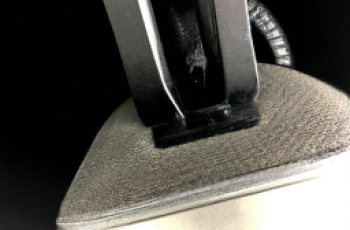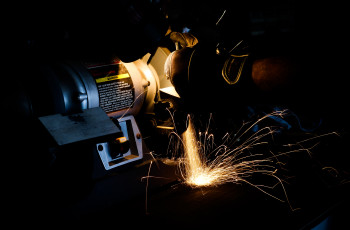Polishing with a Bench Grinder is an essential skill for any DIY enthusiast or professional. In this article, you will discover the key steps and techniques to achieve a flawless finish on metal objects using this versatile tool. From selecting the right grinding wheel to mastering the correct polishing motions, you will gain valuable insights that will elevate your polishing game to a whole new level. So, grab your safety goggles and let’s dive into the world of bench grinder polishing!

Bench Grinder Basics
A bench grinder is a versatile tool that can be used for various tasks, including polishing. It consists of a motor that drives two rotating wheels, typically made of abrasive material. A bench grinder may have different wheel sizes and specifications, allowing for different applications. With the right techniques and safety precautions, you can achieve excellent polishing results using a bench grinder.
What is a bench grinder?
A bench grinder is a stationary tool that is mounted on a workbench or pedestal. It is commonly used for grinding, sharpening, and shaping metal, but it can also be used for polishing and buffing various materials. The grinder typically features two wheels, one for rough grinding and the other for fine grinding or polishing. The wheels rotate at high speeds, providing the necessary abrasive action to smoothen and shine surfaces.
Components of a bench grinder
A typical bench grinder consists of several key components. These include the motor, grinding wheels, wheel guards, tool rests, and an on/off switch. The motor is the heart of the grinder, powering the rotation of the wheels. The grinding wheels come in different sizes and materials, with each wheel designed for specific applications. Wheel guards are essential safety features that protect you from flying debris and sparks. Tool rests provide support for the workpiece and help maintain stability during polishing.
Safety precautions while using a bench grinder
Before starting any polishing project with a bench grinder, it is crucial to prioritize safety. Here are some essential safety precautions to keep in mind:
- Wear appropriate personal protective equipment (PPE), including safety goggles or a face shield, gloves, and hearing protection.
- Ensure the grinder is properly grounded and securely mounted to a stable workbench or pedestal.
- Read and understand the manufacturer’s instructions and warnings before operating the grinder.
- Inspect the grinder and wheels for any damage or defects before use. Do not use a grinder with damaged parts.
- Keep the work area clean and free of clutter. Remove any flammable materials.
- Always use the appropriate wheel for the specific task at hand and follow the manufacturer’s recommendations for speed and usage.
- Maintain a firm and comfortable grip on the workpiece, keeping your hands away from the rotating wheels.
- Avoid wearing loose clothing, jewelry, or long hair that could get caught in the grinder.
- Operate the grinder in a well-ventilated area or use a dust collection system to minimize dust and debris.
- Never leave the grinder unattended while it is running, and always turn off the power when not in use.
By following these safety precautions, you can ensure a safe and enjoyable polishing experience with your bench grinder.
Choosing the Right Wheel
The selection of the right grinding wheel is crucial for achieving the desired polishing results. Various factors need to be considered, such as the material being polished, the finish required, and the type of bench grinder being used.
Grinding wheel types
Grinding wheels are available in different types and compositions, each suitable for specific polishing tasks. Some common types of grinding wheels include:
- Aluminum oxide wheels: These are versatile and long-lasting wheels suitable for general-purpose grinding and polishing tasks.
- Silicon carbide wheels: Ideal for polishing harder materials such as stone, glass, and ceramics.
- Zirconia alumina wheels: Known for their high heat resistance, these wheels are excellent for heavy material removal and grinding stainless steel.
- Diamond wheels: These wheels are designed for precision grinding and polishing of hard materials like carbide, glass, and gemstones.
Understanding wheel specifications
When selecting a grinding wheel, it’s essential to understand the specifications provided by the manufacturer. These specifications include the wheel diameter, grit size, hardness, and bond type.
- Wheel diameter: The size of the wheel determines the surface area and the contact area with the workpiece. Larger wheels are more suitable for heavy-duty polishing, while smaller wheels provide better control and precision for intricate polishing tasks.
- Grit size: The grit size refers to the coarseness or fineness of the abrasive particles on the wheel. Lower grit numbers signify a rougher surface, ideal for rapid material removal. Higher grit numbers indicate a finer surface, perfect for achieving a smooth and polished finish.
- Hardness: Wheel hardness affects the rate of material removal and the surface finish. Softer wheels are more suitable for delicate materials, while harder wheels are better for tougher materials.
- Bond type: The bond refers to the material that holds the abrasive particles in place. Different bond types have different hardness and strength properties, impacting the overall performance and lifespan of the wheel.
Selecting the appropriate wheel for polishing
When selecting a wheel for polishing, consider the material you are working with and the desired finish. For example:
- Metal surfaces: For polishing metal surfaces, aluminum oxide wheels with medium to fine grits are generally suitable. They provide a good balance between material removal and achieving a smooth finish.
- Woodworking projects: For polishing woodworking projects, a softer, high-grit wheel such as silicon carbide or aluminum oxide is commonly used. This helps prevent excessive material removal and leaves a polished surface without damaging the wood.
- Plastic materials: When polishing plastic materials, use a soft grinding wheel with a low grit rating to avoid overheating or melting the plastic. Be cautious of the type of plastic being polished, as some plastics require special care to prevent damage.
- Glass and ceramics: For polishing glass and ceramics, diamond wheels are the preferred choice due to their hardness and precision. These wheels allow for delicate shaping and smoothing of the glass or ceramic surfaces.
By selecting the appropriate wheel for your specific polishing task, you can ensure optimal results and avoid unnecessary damage to your workpiece.
Preparing the Bench Grinder
Before starting any polishing project with a bench grinder, it is essential to adequately prepare the grinder. Proper inspection, cleaning, and wheel installation are necessary steps to ensure optimal performance and safety.
Inspecting the grinder
Before using the bench grinder, carefully inspect all its components for any signs of damage or wear. Start by examining the motor and power cord for any visible defects or fraying. Check the wheel guards to ensure they are intact and securely fastened. Inspect the grinding wheels for any cracks, chips, or uneven wear. If any parts appear damaged or defective, they should be replaced before proceeding with polishing.
Cleaning the grinder
Proper cleaning of the bench grinder is essential before starting any polishing project. Start by unplugging the grinder and removing any debris or dust from the wheel guards and rest. Use a brush or compressed air to remove any buildup or residue on the grinding wheels. It is essential to remove any metal shavings or dust that can get trapped between the wheel and the workpiece, as this can affect the polishing results.
Installing the polishing wheel
Once the grinder is inspected and cleaned, it’s time to install the polishing wheel. Different types of polishing wheels are available, such as soft cotton buffing wheels or felt wheels. The selection of the polishing wheel depends on the material being polished and the desired finish. Follow the manufacturer’s instructions to install the polishing wheel securely. Ensure it is properly aligned and tightened for safe and effective polishing.
By properly preparing the bench grinder, you can ensure its optimal performance and reduce the risk of accidents or damage to the workpiece.
Techniques for Effective Polishing
To achieve effective polishing results with a bench grinder, it is essential to understand the polishing process and master the techniques involved. Proper control of speed, positioning of the workpiece, and application of pressure are key factors in achieving a smooth and polished finish.
Understanding the polishing process
Polishing involves the removal of surface imperfections, scratches, and marks to achieve a smooth and glossy finish. It is a gradual process that requires patience and precision. Proper techniques involve gradually moving from coarser grits to finer grits to achieve the desired smoothness and shine. The polishing process with a bench grinder typically involves the use of polishing compounds or pastes applied to the wheel for enhanced polishing results.
Setting the right speed
The speed at which the bench grinder operates plays a crucial role in the polishing process. Different materials and polishing tasks require different speeds. Generally, a slower speed is recommended for more delicate materials, while a higher speed is suitable for heavier materials. Refer to the manufacturer’s instructions for the recommended speed settings for different polishing tasks. It is important to start at a lower speed and gradually increase if necessary, always keeping safety in mind.
Positioning the workpiece
Proper positioning of the workpiece on the polishing wheel is essential for even and effective polishing. Ensure that the workpiece is held securely and does not wobble during polishing. Use the tool rest as a guide to maintain a consistent angle and avoid uneven polishing. When polishing curved surfaces, such as pipes or contours, it may be necessary to adjust the positioning of the workpiece to ensure an even polish.
Controlling pressure and movement
Applying the right amount of pressure and controlling the movement of the workpiece is crucial for achieving optimal polishing results. Applying excessive pressure can lead to overheating, damaging the workpiece, or causing the polishing wheel to wear down quickly. On the other hand, insufficient pressure may not yield the desired polishing effect. It is important to find a balance and maintain a steady and controlled movement of the workpiece, allowing the polishing wheel to do its job effectively.
By understanding and implementing these polishing techniques, you can achieve the desired smoothness, shine, and finish for your workpiece using a bench grinder.

Polishing Different Materials
Polishing can be applied to various materials, each requiring specific techniques and considerations. Whether you are polishing metal surfaces, woodworking projects, plastic materials, or even glass and ceramics, understanding the unique properties of each material is essential for achieving optimal results.
Polishing metal surfaces
When polishing metal surfaces, consider the type of metal, its hardness, and the desired finish. Start by using a coarser grit wheel to remove any surface imperfections, such as scratches or rust. Gradually move to finer grits for achieving a smooth and polished finish. It is important to cool the workpiece frequently by dipping it in water to prevent overheating. Applying a polishing compound or paste to the wheel can further enhance the polishing process and provide a mirror-like finish.
Polishing woodworking projects
Woodworking projects require a delicate touch when it comes to polishing. Avoid using aggressive grinding wheels that may remove too much material or cause gouges. Instead, use softer polishing wheels with higher grit ratings to achieve a smooth and polished surface. Apply a thin layer of polishing compound to the wheel for better results. It is important to move the workpiece with the grain to minimize the risk of tear-out or scratches.
Polishing plastic materials
Polishing plastic materials requires caution, as they can melt or become damaged if excessive heat is generated. Use a soft grinding wheel with a low grit rating to prevent overheating. Keep the workpiece and the polishing wheel cool by frequently dipping them in water during the polishing process. Be aware of the specific requirements of the plastic being polished to avoid any damage or distortion.
Polishing glass and ceramics
Glass and ceramics require specialized polishing techniques due to their hardness and fragility. Diamond wheels are commonly used for polishing glass and ceramics due to their precision and ability to shape and smooth delicate surfaces. Use a fine grit wheel and apply light pressure to achieve the desired polish. Be cautious of chipping or cracking, and consider using water or lubricating agents during the polishing process to minimize heat buildup and prevent damage.
By understanding the unique polishing requirements of different materials, you can achieve excellent results and enhance the appearance of your workpieces.
Common Polishing Mistakes
Even with the best techniques and equipment, mistakes can happen during the polishing process. Being aware of common mistakes and learning how to avoid them can help you achieve better polishing results with your bench grinder.
Overheating the workpiece
One of the common mistakes during polishing is overheating the workpiece. This can occur when too much pressure is applied or the wheel speed is too high, generating excessive heat. Overheating can lead to material damage, distortion, or even melting. To prevent overheating, ensure the appropriate wheel speed and apply gentle and consistent pressure during polishing. Frequently cooling the workpiece with water can also help minimize the risk of overheating.
Using incorrect wheel RPM
Another mistake to avoid is using incorrect wheel RPM (rotations per minute) for the specific task at hand. Each grinding wheel has a recommended RPM range provided by the manufacturer. Operating the wheel at speeds outside this range can lead to poor polishing results or even accidents. Always refer to the manufacturer’s instructions for the proper wheel RPM, and ensure your bench grinder is equipped with a suitable speed control system. Adjust the speed accordingly to match the requirements of the material being polished.
Applying excessive pressure
Applying excessive pressure during polishing can lead to several issues, including uneven polishing, wheel wear, overheating, and even damage to the workpiece. Remember that the grinding wheel’s abrasive action is designed to work efficiently with moderate pressure. It is crucial to find the right balance and maintain a steady and controlled pressure during polishing. Let the wheel do the work, and avoid the temptation to forcefully press the workpiece against it.
Neglecting safety gear
Safety should be a top priority when using a bench grinder for polishing. Neglecting to wear appropriate personal protective equipment (PPE) can lead to serious injuries. Always wear safety goggles or a face shield to protect your eyes from flying debris. Gloves and hearing protection are also recommended to protect your hands and ears. Long hair should be tied back, and loose clothing and jewelry should be avoided to prevent entanglement with the rotating wheels.
By being mindful of these common polishing mistakes and taking the necessary precautions, you can significantly improve the polishing results while ensuring a safe working environment.

Maintaining the Bench Grinder
Regular maintenance of your bench grinder is essential to ensure its longevity and optimal performance. Proper cleaning, checking for worn-out parts, and conducting periodic maintenance checks can help you avoid unexpected breakdowns and optimize the lifespan of your grinder.
Cleaning the grinder after use
After each use, it is important to clean the bench grinder to remove any accumulated dust, debris, or polishing compounds. Start by unplugging the grinder and removing the wheel guards. Use a brush or compressed air to remove any residual particles, paying close attention to hard-to-reach areas. Inspect the grinding wheels and clean them thoroughly. Make sure to remove any residue that may have accumulated on the tool rests and other parts of the grinder. Finally, reassemble the grinder and store it in a clean and dry location.
Replacing worn-out wheels
With regular use, the grinding wheels on your bench grinder may become worn out or damaged. It is important to inspect the wheels periodically and replace them when necessary. Look for signs of uneven wear, cracks, or chips. Worn-out wheels can affect the polishing results and pose safety risks. Follow the manufacturer’s guidelines for wheel replacement, including the correct type, size, and compatibility with your bench grinder.
Periodic maintenance checks
Performing periodic maintenance checks on your bench grinder can help identify any potential issues before they escalate. Inspect the motor, power cord, and switch for any signs of wear or damage. Check the alignment of the wheel guards and ensure they are securely fastened. Verify that all moving parts, such as the tool rests, are in good working condition. Lubricate any necessary components as recommended by the manufacturer. By being proactive with maintenance, you can prolong the life of your bench grinder and enjoy consistent and reliable performance.
Advanced Polishing Techniques
Once you have mastered the basics of polishing with a bench grinder, you can explore advanced techniques to achieve even more refined results. These techniques involve using different compounds, attachments, and specialized approaches for polishing specific objects or achieving intricate finishes.
Buffing with different compounds
Buffing compounds are abrasive materials used during polishing to achieve a higher degree of smoothness and shine. They are typically applied to the polishing wheel before starting the polishing process. Different compounds are available, each designed for specific materials or finishes. For example, tripoli compound is commonly used for initial rough polishing, while jeweler’s rouge is perfect for achieving a final high-gloss finish. Experiment with different compounds to find the most suitable one for your polishing needs.
Using attachments for precise polishing
Attachments and accessories can further enhance the capabilities of your bench grinder for specific polishing tasks. For instance, a tapered spindle adapter allows the use of smaller polishing wheels, enabling you to reach tight corners or intricate details. A buffing wheel rake is a handy tool for cleaning and reshaping the polishing wheel’s surface, ensuring consistent performance. Explore the variety of attachments available and consider their compatibility with your bench grinder to expand your polishing options.
Polishing small and intricate objects
Polishing small or intricate objects can be challenging, but with the right techniques, it can yield impressive results. One approach is to use a handheld mandrel with a small polishing wheel attached. This allows you to precisely control the polishing process and reach confined areas. Alternatively, you can also use felt bobs or cotton mops mounted on a rotary tool to polish small objects that require delicate handling.
By delving into advanced polishing techniques, you can elevate your polishing skills and achieve professional-quality finishes with your bench grinder.
Safety Tips for Polishing
Polishing with a bench grinder involves potential hazards, and it is crucial to prioritize safety at all times. Following these safety tips will help minimize the risk of accidents and ensure a safe working environment.
Wearing personal protective equipment
Always wear the appropriate personal protective equipment (PPE) when operating a bench grinder for polishing. Safety goggles or a face shield will protect your eyes from flying debris and sparks. Gloves can shield your hands and provide better grip and control. Use hearing protection if the noise level of your grinder is significant. PPE should be worn at all times throughout the polishing process.
Securing workpiece for stability
To prevent accidents or injuries, ensure that the workpiece is securely and stably held in place during polishing. Unstable or loose workpieces can shift or wobble, increasing the risk of accidents. Use clamps, vises, or other appropriate holding devices to secure the workpiece firmly. This will allow you to maintain better control and reduce the chances of the workpiece being caught in the spinning wheels.
Avoiding loose clothing and jewelry
Loose clothing, long hair, and jewelry can pose significant hazards when polishing with a bench grinder. Avoid wearing loose or baggy clothing that could get caught in the rotating wheels. Tie back long hair and remove any jewelry, including rings, bracelets, or necklaces. Loose clothing, hair, or jewelry caught in the grinder can cause severe injuries or damage to the equipment.
Keeping the workspace well-ventilated
Polishing with a bench grinder can generate dust, debris, and fumes. It is important to work in a well-ventilated area to prevent inhalation of fine particles or exposure to potentially harmful substances. Ensure there is adequate airflow in your workspace, or use a dust collection system to minimize dust buildup. This will help maintain a healthy and safe working environment.
By strictly adhering to these safety tips, you can enjoy the benefits of polishing with a bench grinder while minimizing the risk of accidents or injuries.
Alternatives to Bench Grinders for Polishing
While bench grinders are versatile tools for polishing, several alternatives are available for specialized applications or specific materials. These alternatives offer different advantages and additional polishing options.
Hand polishing tools
Hand polishing tools, such as sandpaper, files, or abrasive pads, provide a more hands-on and precise approach to polishing. They are especially useful for smaller objects or intricate details that may be challenging to polish with a bench grinder. Hand polishing allows for better control and a gentler touch, ensuring minimal material removal and a finer finish. However, hand polishing may be more time-consuming and labor-intensive compared to using a bench grinder.
Rotary tools
Rotary tools, such as Dremel tools or flex shaft grinders, can be excellent alternatives to bench grinders for more delicate or detailed polishing tasks. These handheld tools offer high speeds and various attachments, making them suitable for intricate polishing of small objects or hard-to-reach areas. Rotary tools are compact, versatile, and provide precise control, making them a favorite among hobbyists and craftsmen.
Power sanders
Power sanders, such as random orbital sanders or belt sanders, can be used for polishing larger surfaces or materials that require substantial material removal. They are particularly useful when working with wood, as they can quickly remove scratches or imperfections and create a smooth surface for subsequent polishing. Power sanders are available in different sizes and grit options, offering versatility and efficiency for various polishing tasks.
By exploring these alternatives, you can find the most suitable tool for your specific polishing needs, considering factors such as material type, desired finish, and the level of precision required.
In conclusion, polishing with a bench grinder can be a rewarding and efficient way to improve the appearance and shine of various materials. By understanding the basics, selecting the right wheel, mastering the techniques, and prioritizing safety, you can achieve professional-quality polishing results. Remember to maintain your bench grinder properly and explore advanced polishing techniques for more refined finishes. Consider the alternatives to bench grinders when tackling specialized polishing tasks or materials. With practice and attention to detail, you can take your polishing skills to the next level and enjoy the satisfaction of beautifully polished objects.



